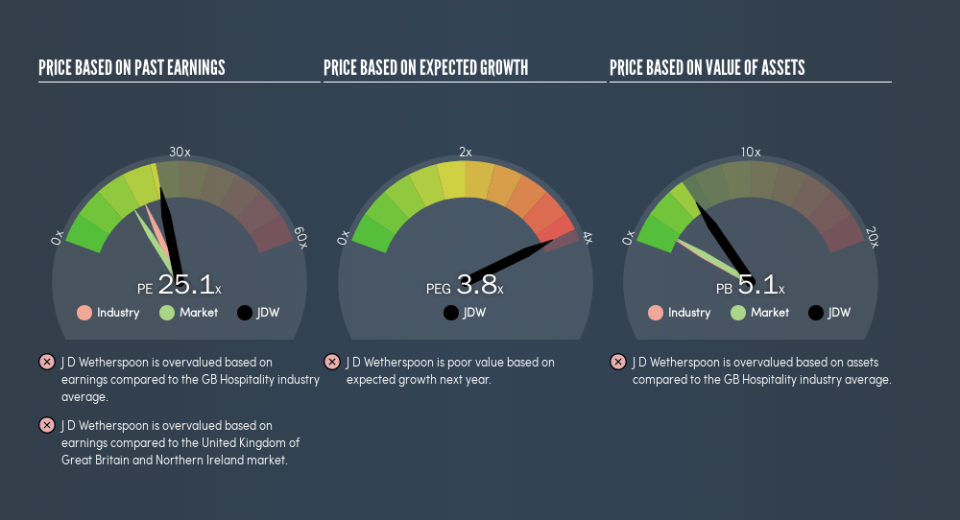Despite Its High P/E Ratio, Is J D Wetherspoon plc (LON:JDW) Still Undervalued?

This article is written for those who want to get better at using price to earnings ratios (P/E ratios). We'll look at J D Wetherspoon plc's (LON:JDW) P/E ratio and reflect on what it tells us about the company's share price. Looking at earnings over the last twelve months, J D Wetherspoon has a P/E ratio of 25.27. In other words, at today's prices, investors are paying £25.27 for every £1 in prior year profit.
View our latest analysis for J D Wetherspoon
How Do You Calculate A P/E Ratio?
The formula for price to earnings is:
Price to Earnings Ratio = Share Price ÷ Earnings per Share (EPS)
Or for J D Wetherspoon:
P/E of 25.27 = £15.48 ÷ £0.61 (Based on the trailing twelve months to January 2019.)
Is A High Price-to-Earnings Ratio Good?
A higher P/E ratio means that buyers have to pay a higher price for each £1 the company has earned over the last year. All else being equal, it's better to pay a low price -- but as Warren Buffett said, 'It's far better to buy a wonderful company at a fair price than a fair company at a wonderful price.'
Does J D Wetherspoon Have A Relatively High Or Low P/E For Its Industry?
One good way to get a quick read on what market participants expect of a company is to look at its P/E ratio. The image below shows that J D Wetherspoon has a higher P/E than the average (19.7) P/E for companies in the hospitality industry.
Its relatively high P/E ratio indicates that J D Wetherspoon shareholders think it will perform better than other companies in its industry classification. The market is optimistic about the future, but that doesn't guarantee future growth. So investors should always consider the P/E ratio alongside other factors, such as whether company directors have been buying shares.
How Growth Rates Impact P/E Ratios
Generally speaking the rate of earnings growth has a profound impact on a company's P/E multiple. When earnings grow, the 'E' increases, over time. That means unless the share price increases, the P/E will reduce in a few years. And as that P/E ratio drops, the company will look cheap, unless its share price increases.
J D Wetherspoon saw earnings per share decrease by 4.1% last year. But EPS is up 9.8% over the last 5 years.
A Limitation: P/E Ratios Ignore Debt and Cash In The Bank
One drawback of using a P/E ratio is that it considers market capitalization, but not the balance sheet. So it won't reflect the advantage of cash, or disadvantage of debt. Hypothetically, a company could reduce its future P/E ratio by spending its cash (or taking on debt) to achieve higher earnings.
Spending on growth might be good or bad a few years later, but the point is that the P/E ratio does not account for the option (or lack thereof).
How Does J D Wetherspoon's Debt Impact Its P/E Ratio?
J D Wetherspoon has net debt equal to 48% of its market cap. While it's worth keeping this in mind, it isn't a worry.
The Bottom Line On J D Wetherspoon's P/E Ratio
J D Wetherspoon's P/E is 25.3 which is above average (16.3) in its market. With some debt but no EPS growth last year, the market has high expectations of future profits.
When the market is wrong about a stock, it gives savvy investors an opportunity. As value investor Benjamin Graham famously said, 'In the short run, the market is a voting machine but in the long run, it is a weighing machine.' So this free visualization of the analyst consensus on future earnings could help you make the right decision about whether to buy, sell, or hold.
But note: J D Wetherspoon may not be the best stock to buy. So take a peek at this free list of interesting companies with strong recent earnings growth (and a P/E ratio below 20).
We aim to bring you long-term focused research analysis driven by fundamental data. Note that our analysis may not factor in the latest price-sensitive company announcements or qualitative material.
If you spot an error that warrants correction, please contact the editor at editorial-team@simplywallst.com. This article by Simply Wall St is general in nature. It does not constitute a recommendation to buy or sell any stock, and does not take account of your objectives, or your financial situation. Simply Wall St has no position in the stocks mentioned. Thank you for reading.

 Yahoo Finance
Yahoo Finance 
